List of rulers of the Netherlands
The Netherlands, or Low Countries, possessed clearly delineated boundaries only after 1500. Still in many respects they demonstrated common traits and underwent similar development that differentiated them from surrounding countries. The social, economic and political similarities evident throughout most of the region stem from the High Middle Ages, when the Scheldt, Maas and Rhine delta area became an important center of trade. Next to Northern Italy, the Low Countries became the most urbanised and prosperous region in Europe.
Its political system exhibited, from relatively early on, a degree of representative government that differed from the more feudal arrangements then existent in much of Europe. Internationally, the region served both as a mediator for and a buffer to the surrounding great powers, France, England, and Germany.[1]
Counts of Burgundian and Habsburg Netherlands (1433–1581)
Burgundian dukes acquired a continuous territory covering most of modern-day Belgium and the Netherlands. By establishing the States General, Philip the Good centralised power, thereby laying the basis for the Netherlands as a single country with a common interest. The Burgundian dukes - and later the monarchs of Habsburg Spain - appointed stadtholders (place holders or deputies) in each one of its estates in the Netherlands.
In 1506, at the death of Philip the Handsome, the title "Lord of the Netherlands" or "Lord of Flanders" was given to his son and Duke of Burgundy Charles of Ghent (later Charles I in Spain and Charles V in the Holy Roman Empire). With the Pragmatic Sanction of 1549, Charles completed the process of consolidation by becoming the sole feudal overlord of the Seventeen Provinces. In 1556, the Spanish Netherlands were established under the control of Philip II of Spain. In this political union, the stadtholders served under a governor-general, limiting their power and of the estates.
| Name | Lifespan | Reign start | Reign end | Notes | Family | Image |
|---|---|---|---|---|---|---|
Philip I
| 1433 | 1467 | a.k.a. Philip III of Burgundy | Valois-Burgundy | 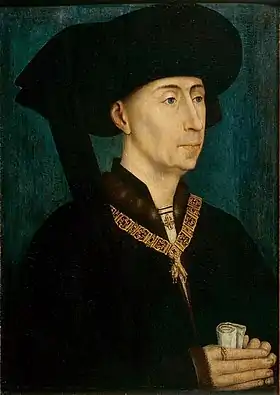 | |
Charles I
| 1467 | 1477 | a.k.a. duke of Burgundy, Brabant, Limburg, Guelder and Luxembourg, count of Flanders, Hainaut, Holland, Zeeland, Zutphen | Valois-Burgundy | 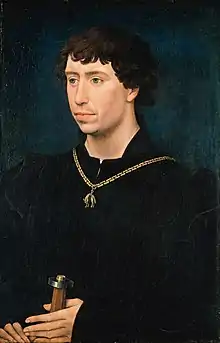 | |
Mary
| 1477 | 1482 | daughter of Charles I | Valois-Burgundy | 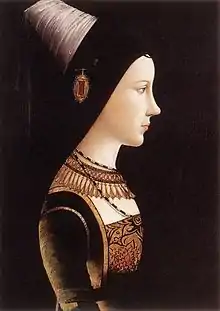 |
| Name | Lifespan | Reign start | Reign end | Notes | Family | Image |
|---|---|---|---|---|---|---|
Maximilian I
| 1482 | 1494 | a.k.a. Holy Roman Emperor[2] | Habsburg |  | |
Philip II
| 1494 | 1506 | a.k.a. king Philip I of Castile; son of Maximilian I | Habsburg | %252C_%252C_Kunsthistorisches_Museum_Wien%252C_Gem%C3%A4ldegalerie_-_Philipp_der_Sch%C3%B6ne_(1478-1506)_-_GG_3872_-_Kunsthistorisches_Museum.jpg.webp) | |
Charles II
| 1506 | 1555 | son of Philip the Handsome; introduced title Lord of the Netherlands; a.k.a. Charles V, Holy Roman Emperor and king Charles I of Spain; regent: Maximilian I (1506 to 1515); governors-general: William de Croÿ (1504-1507), Margaret of Austria (1507-1530) and Mary of Austria (1531-1555) | Habsburg |  | |
Philip III
| 1555 | 1581 | Lord of the Netherlands; a.k.a. king Philip II of Spain; son of Charles I of Spain; governors-general: Emmanuel Philibert of Savoy (1555-1559) and Margaret of Parma (1559-1567) | Habsburg | 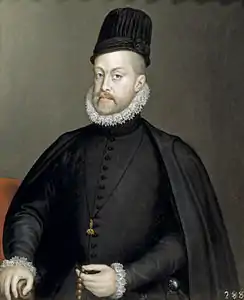 |
The Seven United Netherlands (1581–1795)
Unhappy with the centralisation of political power to Habsburg Spain, seven northern provinces seceded into the Dutch Republic: Groningen, Frisia, Overijssel, Guelders, Utrecht, Holland and Zeeland. They kept parts of Limburg, Brabant and Flanders during and after the Eighty Years' War as Generality Lands.
Military control was given to a stadtholder who in theory was elected by the States-General of the Netherlands of the now independent Dutch Republic. The function was de facto hereditary in Holland and Zeeland, and held by the Prince of Orange. Drawn from a side branch of the House of Orange, Frisia and Groningen had a different stadtholder, until 1711. The following centuries saw the republic being co-ruled by the grand pensionary of the states-general and the stadtholders, with continuous power struggle between the offices.
Stadtholderate under the House of Orange-Nassau
| Name | Lifespan | Reign start | Reign end | Notes | Family | Image |
|---|---|---|---|---|---|---|
William I
| 24 April 1533 – 10 July 1584 (aged 51) | 26 July 1581 | 10 July 1584 | Stadtholder[3] | Orange-Nassau | 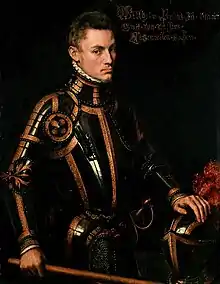 |
Maurice
| 14 November 1567 – 23 April 1625 (aged 57) | 14 November 1585[4] | 23 April 1625 | Stadtholder,[5] son of William I | Orange-Nassau |  |
Frederick Henry
| 29 January 1584 – 14 March 1647 (aged 63) | 23 April 1625 | 14 March 1647 | Stadtholder,[6] son of William I | Orange-Nassau | 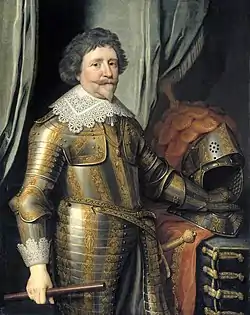 |
William II
| 27 May 1626 – 6 November 1650 (aged 24) | 14 March 1647 | 6 November 1650 | Stadtholder,[7] son of Frederick Henry | Orange-Nassau | 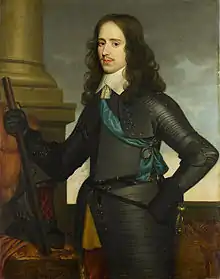 |
William III
| 4 November 1650 – 8 March 1702 (aged 51) | 4 July 1672 | 8 March 1702 | Stadtholder,[8] son of William II also King of England, Scotland and Ireland | Orange-Nassau | .jpg.webp) |
William IV
| 1 September 1711 – 22 October 1751 (aged 40) | 4 May 1747 | 22 October 1751 | First formally hereditary Stadtholder of the United Netherlands,[9] son of John William Friso | Orange-Nassau | 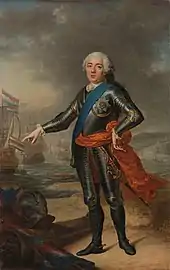 |
William V
| 8 March 1748 – 9 April 1806 (aged 58) | 22 October 1751 | 19 January 1795 | Hereditary Stadtholder of the United Netherlands, son of William IV, deposed by the Batavian Revolution | Orange-Nassau |  |
When William III died childless, the patrilineal ancestry of Orange-Nassau became extinct. In contrast to other provinces of the Dutch Republic, Friesland, Groningen and Drenthe had mostly drawn its stadtholders from the House of Nassau, that starting with John VI, the brother of William of Orange, and comprises in addition a matrilineal ancestry with the house of Orange-Nassau.
Stadtholderate under the House of Nassau
| Name | Lifespan | Reign start | Reign end | Notes | Family | Image |
|---|---|---|---|---|---|---|
John VI
| 22 November 1536 – 8 October 1606 (aged 69) | 1578 | 1581 | Stadtholder,[10] brother of William I | Nassau |  |
William Louis
| 13 March 1560 – 31 May 1620 (aged 60) | 1584 | 1620 | Stadtholder,[11] son of John VI | Nassau | 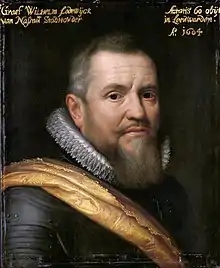 |
Ernest Casimir I
| 22 December 1573 – 2 June 1632 (aged 58) | 1620 | 1632 | Stadtholder,[12] son of John VI | Nassau | .jpg.webp) |
Henry Casimir I
| 21 January 1612 – 13 July 1640 (aged 28) | 1632 | 1640 | Stadtholder,[13] son of Ernest Casimir I | Nassau |  |
William Frederick
| 7 August 1613 – 31 October 1664 (aged 51) | 1640 | 1664 | Stadtholder,[14] son of Ernest Casimir I | Nassau | _Governor_of_Frisia_1664.jpg.webp) |
Henry Casimir II
| 18 January 1657 – 25 March 1696 (aged 39) | 18 January 1664 | 25 March 1696 | Hereditary Stadtholder,[15] son of William Frederick and maternal grandson of Frederick Henry | Nassau |  |
John William Friso
| 4 August 1687 – 14 July 1711 (aged 23) | 25 March 1696 | 14 July 1711 | Hereditary Stadtholder,[16] son of Henry Casimir II, succeeded by his son William IV of Orange-Nassau, Hereditary Stadtholder of the United Netherlands | Nassau | _by_Lancelot_Volders.jpg.webp) |
Grand Pensionaries of the Dutch Republic
Holland formally adopted the Act of Abjuration in 1581 to become a province in the Republic of the Seven United Netherlands. Grand Pensionaries of the province of Holland during the time of the Republic of the Seven United Netherlands:
| Portrait | Name (Birth–Death) |
Term of office | ||
|---|---|---|---|---|
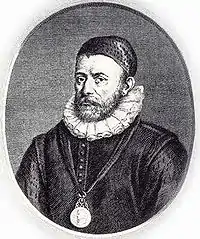 |
Paulus Buys (1531–1594) |
1572 | 16 March 1584 | |
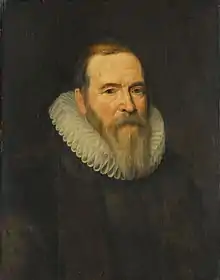 |
Johan van Oldenbarnevelt (1547–1619) |
16 March 1586 |
12 May 1619 | |
| Andries de Witt (1573–1637) |
12 May 1619 |
1621 | ||
| Anthonie Duyck (1560–1629) |
1621 | 1629 | ||
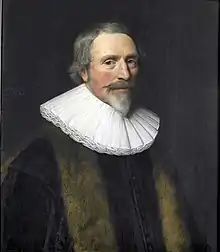 |
Jacob Cats (1577–1660) |
1629 | 1631 | |
.jpg.webp) |
Adriaan Pauw (1585–1653) |
1631 | 1636 | |
 |
Jacob Cats (1577–1660) |
1636 | 1651 | |
.jpg.webp) |
Adriaan Pauw (1585–1653) |
1651 | 30 July 1653 | |
 |
Johan de Witt (1625–1672) |
30 July 1653 |
4 August 1672 | |
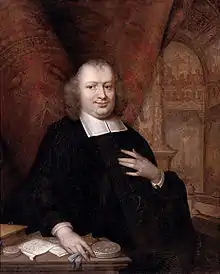 |
Gaspar Fagel (1634–1688) |
20 August 1672 |
5 December 1688 | |
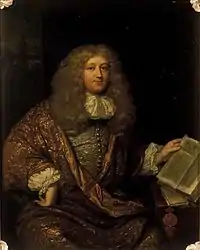 |
Michiel ten Hove (1640–1689) |
5 December 1688 |
24 March 1689 | |
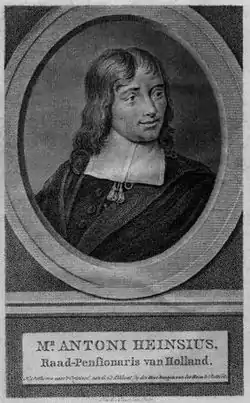 |
Anthonie Heinsius (1641–1720) |
27 May 1689 |
3 August 1720 | |
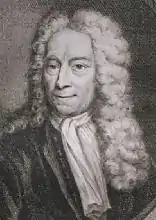 |
Isaac van Hoornbeek (1655–1727) |
12 September 1720 |
17 June 1727 | |
.jpg.webp) |
Simon van Slingelandt (1664–1736) |
17 July 1727 |
1 December 1736 | |
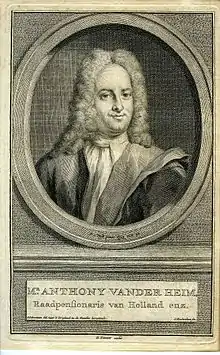 |
Anthonie van der Heim (1693–1746) |
4 April 1737 |
7 July 1746 | |
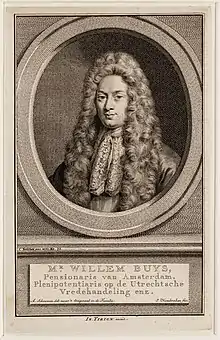 |
Willem Buys (1661–1749) |
7 July 1746 |
23 September 1746 | |
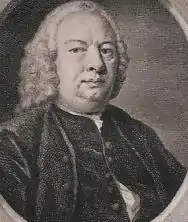 |
Jacob Gilles (1691–1765) |
23 September 1746 |
18 June 1749 | |
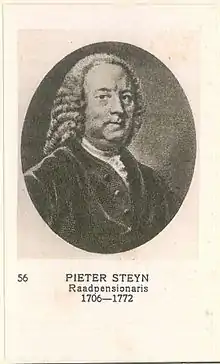 |
Pieter Steyn (1706–1772) |
18 June 1749 |
5 November 1772 | |
%252C_raadpensionaris_van_Holland_Rijksmuseum_SK-A-4336.jpeg.webp) |
Pieter van Bleiswijk (1724–1790) |
18 June 1772 |
5 November 1787 | |
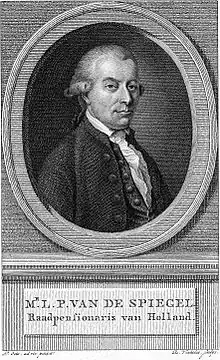 |
Laurens Pieter van de Spiegel (1736–1800) |
9 November 1787 |
9 February 1795 | |
Rulers during the French period (1795–1813)
In the Northern Netherlands, the stadtholdership developed into a hereditary system, with increasing power accumulating to the stadtholder. Dutch Patriots sought a more democratic form of government. With French help they proclaimed the Batavian Republic (1795-1806). In 1806, Napoleon Bonaparte overturned the Batavian Republic. Napoleon established a client Kingdom of Holland with his brother as king (1806-1810). The Netherlands were subsequently annexed into the First French Empire (1810-1813). Stadtholder William V went in exile. The Southern Netherlands (Austrian Netherlands) including Prince-Bishopric of Liège were annexed into the French First Republic (1795–1804) and the First French Empire (1804–1815).
Batavian Republic (1795–1806)
Executive Governments of the Batavian Republic
| Portrait | Name | Term of office | |
|---|---|---|---|
| Revolutionary Committee | 17 January 1795 |
6 February 1795 | |
| States General of the Batavian Republic | 30 March 1795 |
1 March 1796 | |
| National Assembly | 1 March 1796 |
25 January 1798 | |
| Uitvoerend Bewind | 25 January 1798 |
17 October 1801 | |
| Staatsbewind | 17 October 1801 |
29 April 1805 | |
Grand Pensionaries of the Batavian Republic:
| Portrait | Name (Birth–Death) |
Term of office | Faction | |
|---|---|---|---|---|
.jpg.webp) |
Rutger Jan Schimmelpenninck (1761–1825) |
15 May 1805 |
4 June 1806 |
Moderate |
_2.jpg.webp) |
Carel de Vos van Steenwijk (1759–1830) |
4 June 1806 |
18 June 1806 |
Federalist |
Kingdom of Holland (1806–1810)
| Name | Lifespan | Reign start | Reign end | Notes | Family | Image |
|---|---|---|---|---|---|---|
Louis I
| 2 September 1778 – 25 July 1846 (aged 67) | 5 June 1806 (office established) | 1 July 1810 | Napoleon Bonaparte restyled the Netherlands into the Kingdom of Holland, putting his brother Louis I on the throne | Bonaparte | 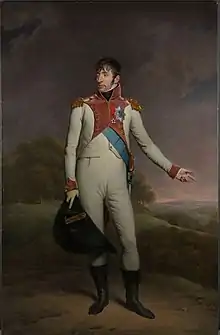 |
Louis II
| 11 October 1804 – 17 March 1831 (aged 26) | 1 July 1810 | 9 July 1810 (office abolished | son of Louis I | Bonaparte | .jpg.webp) |
Rulers of the Netherlands (1813–present)
After the First French Empire collapsed, the crown was offered to sovereign prince William VI, son of stadtholder William V. The Congress of Vienna reunited the Northern Netherlands with the Southern Netherlands into the United Kingdom of the Netherlands of which William became king. The newly appointed kings originally had extensive powers. Constitutional reforms in 1848 transformed the Netherlands into a constitutional monarchy under the rule of law, ending the factual rule of the monarchs.
The Belgian Revolution led to the secession of the southern part into the Kingdom of Belgium.
The non-French speaking part of Luxembourg remained in a personal union with the Netherlands, until William III died, leaving only his daughter Wilhelmina as an heir. Luxembourg allowed inheritance of the crown by males only, hence breaking the personal union.
| Name | Lifespan | Reign start | Reign end | Notes | Family | Image |
|---|---|---|---|---|---|---|
William I
| 24 August 1772 – 12 December 1843 (aged 71) | 6 December 1813 | 7 October 1840 | Son of the last Stadtholder William V Abdicated | Orange-Nassau | 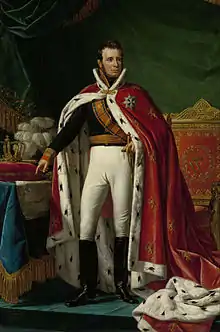 |
William II
| 6 December 1792 – 17 March 1849 (aged 56) | 7 October 1840 | 17 March 1849 | Son of William I | Orange-Nassau | 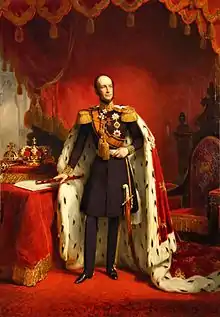 |
William III
| 19 February 1817 – 23 November 1890 (aged 73) | 17 March 1849 | 23 November 1890 | Son of William II | Orange-Nassau | %252C_koning_der_Nederlanden%252C_Nicolaas_Pieneman%252C_1856_-_Rijksmuseum.jpg.webp) |
| Wilhelmina | 31 August 1880 – 28 November 1962 (aged 82) | 23 November 1890 | 4 September 1948 | Daughter of William III Abdicated | Orange-Nassau | 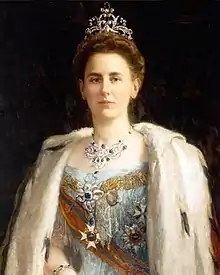 |
| Juliana | 30 April 1909 – 20 March 2004 (aged 94) | 4 September 1948 | 30 April 1980 | Daughter of Wilhelmina Abdicated | Orange-Nassau (Mecklenburg) | 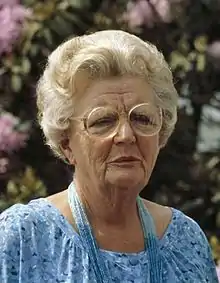 |
| Beatrix | 31 January 1938 | 30 April 1980 | 30 April 2013 | Daughter of Juliana Abdicated | Orange-Nassau (Lippe) | 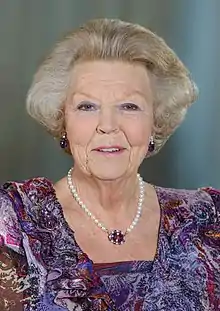 |
William-Alexander
| 27 April 1967 | 30 April 2013 | Incumbent | Son of Beatrix | Orange-Nassau (Amsberg) | 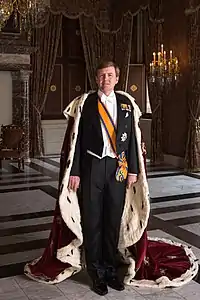 |
See also
References
- Blom, J. C. H.; Lamberts, E. (June 2006). History of the Low Countries. ISBN 9781845452728.
- Established Habsburg rule in Spain by marrying his son Philip the Handsome to the future Queen Joanna of Castile.
- Stadtholder of Holland, Zeeland and Utrecht (1559–1584), Stadtholder of Friesland and Overijssel (1580–1584)
- Maurits benoemd als stadhouder, 1585, Europeana
- Stadtholder of Holland and Zeeland (1585–1625), Utrecht, Guelders and Overijssel (1590–1625), Groningen (1620–1625)
- Stadtholder of Holland, Zeeland, Utrecht, Guelders, and Overijssel (1620–1625), Groningen and Drenthe (1640–1647)
- Stadtholder of Holland, Zeeland, Utrecht, Guelders, Groningen, Drenthe and Overijssel
- Stadtholder of Holland, Zeeland, Utrecht and Overijssel (1672–1702), Guelders (1675–1702), Drenthe (1696–1702)
- Hereditary Stadtholder of Friesland (1711–1747), Holland, Zeeland, Utrecht and Overijssel (April/May 1747 – November 1747), Stadtholder of Groningen (1718–1747), Guelders and Drenthe (1722–1747), was formally voted the first Hereditary Stadtholder of the United Provinces (1747–1751)
- Stadtholder of Guelders (under Philip II), architect of the Union of Utrecht
- Stadtholder of Friesland (1584–1620), Groningen (1594–1620) and Drenthe (1596–1620)
- Stadtholder of Friesland (1620–1632), Groningen and Drenthe (1625–1632)
- Stadtholder of Friesland (1632–1640), Groningen and Drenthe (1632–1640)
- Stadtholder of Friesland (1640–1664), Groningen and Drenthe (1650–1664)
- In 1675 the State of Friesland voted to make the Stadtholdership hereditary in the house of Nassau-Dietz
- Hereditary Stadtholder of Friesland (1707–1711) and Groningen (1708–1711)